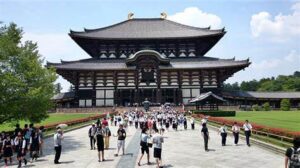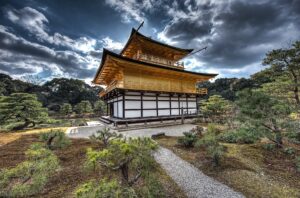
In this article, we will discuss the top 10 historical sites for tourists in Japan, offering unique experiences that showcase its rich cultural heritage and history.
1. Kyoto Imperial Palace (Kyoto):
2. Himeji Castle (Himeji):
3. Hiroshima Peace Memorial Park (Hiroshima):
4. Todai-ji Temple (Nara):
5. Kinkaku-ji Temple (Kyoto):
6. Matsumoto Castle (Nagano):
7. Itsukushima Shrine (Hiroshima):
8. Nikko Toshogu Shrine (Tochigi):
9. Koya-san (Wakayama):
10. Kanazawa Castle (Kanazawa):
1. Kyoto Imperial Palace (Kyoto) Japan:

The Kyoto Imperial Palace, located in the heart of Kyoto, Japan, is one of the historical sites and a must-visit for tourists wishing to glimpse Japan’s rich history and culture.
This historic site served as the residence of the Imperial family until the capital was moved to Tokyo in 1869.
Visitors to the Kyoto Imperial Palace can explore the beautiful gardens, and traditional Japanese architecture, and learn about the fascinating history of the Imperial family.
The palace grounds are meticulously maintained, offering a serene and peaceful atmosphere that transports visitors back in time.
One of the highlights of a visit to the Kyoto Imperial Palace is the opportunity to participate in a guided tour.
Knowledgeable guides provide insights into the significance of each building and garden, as well as the rituals and ceremonies that took place within the palace walls.
In addition to the main palace buildings, visitors can also explore the surrounding park area, which is home to cherry blossoms in the spring and vibrant foliage in the fall.
The picturesque scenery provides the perfect backdrop for a leisurely stroll or a peaceful moment of reflection.
For those interested in Japanese history and architecture, a visit to the Kyoto Imperial Palace is a truly enriching experience.
Whether you are a history buff, a nature lover, or simply looking to immerse yourself in the beauty of traditional Japanese culture, the Kyoto Imperial Palace is a destination not to be missed.
2. Himeji Castle (Himeji) Japan:

Himeji Castle, located in the city of Himeji in Japan, is a stunning example of traditional Japanese architecture and a UNESCO World Heritage Site.
Known as the “White Heron Castle” due to its elegant white exterior and resemblance to a bird taking flight, Himeji Castle is one of Japan’s most iconic and well-preserved castles.
For tourists visiting historical sites of Japan, a trip to Himeji Castle is a must for a glimpse into the country’s feudal past and architectural marvels.
The castle complex consists of multiple buildings, towers, and gates surrounded by defensive walls and moats, creating a picturesque and imposing sight.
Visitors can explore the castle’s interior, which features intricate wooden carvings, sliding doors, and tatami mat floors that offer a glimpse into the lifestyle of feudal lords and samurai warriors.
Guided tours are available for tourists to learn about the history of Himeji Castle, including its strategic importance during Japan’s feudal era and its architectural significance.
The castle’s main keep offers panoramic views of the surrounding city and countryside, making it a perfect spot for photography enthusiasts.
Surrounded by beautiful cherry blossom trees, Himeji Castle is particularly stunning during the spring when the cherry blossoms are in full bloom.
The castle’s grounds also feature traditional Japanese gardens, teahouses, and a nearby park, providing a peaceful retreat for visitors to relax and enjoy the serene beauty of the castle and its surroundings.
Overall, a visit to Himeji Castle is a memorable and enriching experience for tourists who want to visit historical sites to immerse themselves in the history, culture, and architectural heritage of Japan.
3. Hiroshima Peace Memorial Park (Hiroshima) Japan:

Hiroshima Peace Memorial Park, located in Hiroshima, Japan, is a poignant and historically significant site that serves as a powerful reminder of the devastating impact of nuclear warfare.
Established in memory of the victims of the atomic bombing of Hiroshima during World War II, the park stands as a symbol of peace, resilience, and hope for a nuclear-free world.
Visitors to Hiroshima Peace Memorial Park can explore various memorials, monuments, and museums that pay tribute to the lives lost and the survivors’ stories.
The iconic Genbaku Dome, also known as the Atomic Bomb Dome is a UNESCO World Heritage Site that stands as a haunting reminder of the destructive power of nuclear weapons.
The Peace Memorial Museum offers a comprehensive look at the events leading up to the bombing and its aftermath, providing visitors with a deeper understanding of the human cost of war.
Strolling through the park’s tranquil gardens and reflecting at the Memorial Cenotaph, visitors can pay their respects to the victims and contemplate the importance of peace and reconciliation.
The park also hosts the annual Peace Memorial Ceremony on August 6th, the anniversary of the bombing, where people from around the world come together to honor the victims and reaffirm their commitment to peace.
For tourists looking for historical sites and a meaningful and educational experience in Japan, a visit to Hiroshima Peace Memorial Park is a must-see that offers deep insight into the aftermath of the war and the enduring spirit of resilience and hope.
4. Todai-ji Temple (Nara) Japan:

Todai-ji Temple, located in Nara, Japan, is one of the historical sites and a must-see for tourists seeking a blend of history, culture, and spirituality.
As one of Japan’s most iconic and historically significant temples, Todai-ji holds a special place in the hearts of locals and visitors alike.
The temple is home to the Daibutsu, or Great Buddha, a massive bronze statue that stands over 15 meters tall and is a sight to behold.
Visitors can marvel at the intricate details of the statue and feel a sense of awe at its sheer size and craftsmanship.
In addition to the Great Buddha, Todai-ji Temple is also known for its beautiful architecture, including the main hall, which is one of the largest wooden buildings in the world.
The surrounding gardens and grounds offer a peaceful retreat from the hustle and bustle of everyday life, making it the perfect place for quiet contemplation and reflection.
Visitors can also explore the temple’s museum, which houses a collection of artifacts and treasures that provide insight into the history and significance of Todai-ji.
From ancient scrolls to intricate carvings, the museum offers a glimpse into the rich cultural heritage of Japan.
Overall, a visit to Todai-ji Temple is a truly immersive experience that allows tourists to connect with Japan’s past and present. Whether you are a history buff, a spiritual seeker, or simply a curious traveler,
Todai-ji Temple has something to offer everyone. So, don’t miss the opportunity to explore this cultural gem during your visit to Nara.
5. Kinkaku-ji Temple (Kyoto) Japan:

Kinkaku-ji Temple, also known as the Golden Pavilion, is a stunning and iconic cultural landmark located in Kyoto, Japan, that captivates tourists with its breathtaking beauty and serene atmosphere.
The temple’s top two floors are covered in shimmering gold leaf, creating a mesmerizing reflection on the tranquil pond that surrounds it.
This shimmering golden facade is a sight to behold, especially during sunrise or sunset when the temple seems to glow with an ethereal light.
Visitors to Kinkaku-ji Temple can explore the meticulously landscaped gardens that offer a peaceful retreat from the bustling city.
The temple’s grounds are meticulously maintained, with lush greenery, vibrant flowers, and winding pathways that lead to hidden corners and scenic viewpoints.
The Zen rock garden, known as the Hojo Garden, provides a tranquil space for contemplation and meditation, while the teahouse offers visitors a chance to experience a traditional Japanese tea ceremony.
Steeped in history and spirituality, Kinkaku-ji Temple is a UNESCO World Heritage Site that dates back to the 14th century.
The temple’s architecture reflects a harmonious blend of traditional Japanese design and Zen Buddhist principles, creating a sense of harmony and balance that resonates with visitors.
Whether you are a history enthusiast, a nature lover, or simply seeking a moment of tranquility, a visit to Kinkaku-ji Temple is sure to leave a lasting impression and create unforgettable memories of your time in Kyoto.
6. Matsumoto Castle (Nagano) Japan:

Matsumoto Castle, located in Nagano, Japan, is a stunning and well-preserved historic landmark that offers tourists a glimpse into Japan’s feudal past.
Known as one of the country’s most beautiful and unique castles, Matsumoto Castle is a must-visit destination for history buffs and architecture enthusiasts alike.
The castle’s striking black exterior, wooden interiors, and elegant design make it a true masterpiece of Japanese castle architecture.
Visitors to Matsumoto Castle can explore the various levels of the castle, including the main keep, watchtowers, and moon-viewing platform, each offering panoramic views of the surrounding landscape.
The castle’s interior features well-preserved tatami mat rooms, steep staircases, and hidden passageways that transport visitors back in time to the days of samurai warriors and feudal lords.
Surrounded by a picturesque moat and set against the backdrop of the Japanese Alps, Matsumoto Castle is not only a historical gem but also a scenic marvel.
The castle’s grounds are beautifully landscaped with cherry blossom trees, traditional gardens, and peaceful ponds, creating a tranquil oasis in the heart of Nagano.
In addition to exploring the castle itself, visitors can also learn about the history and significance of Matsumoto Castle at the on-site museum, which displays artifacts, weapons, and armor from the castle’s storied past.
Whether you are interested in history, architecture, or simply appreciate the beauty of Japan’s cultural heritage, a visit to Matsumoto Castle is sure to be a memorable and enriching experience for tourists of all ages.
7. Itsukushima Shrine (Hiroshima) Japan:

Itsukushima Shrine, located in Hiroshima, Japan, is a sacred and picturesque Shinto shrine that sits on the island of Miyajima, known for its iconic “floating” torii gate.
This UNESCO World Heritage Site is one of the historical sites in Japan and is a popular destination for tourists seeking a combination of natural beauty, cultural significance, and spiritual tranquility.
The shrine’s unique design, with its vermilion-colored buildings set against the backdrop of the Seto Inland Sea and lush mountains, creates a stunning and harmonious landscape that is truly awe-inspiring.
One of the most famous features of Itsukushima Shrine is the O-torii gate, which appears to float on the water during high tide, making it a symbol of the shrine and a must-see sight for visitors.
The gate’s reflection in the water adds to the ethereal beauty of the shrine, especially during sunrise or sunset when the colors of the sky and sea blend together in a mesmerizing display.
Visitors to Itsukushima Shrine can explore the various structures on the island, including the main hall, prayer halls, and stage that overlooks the sea.
The shrine’s architecture, with its intricate wooden carvings, traditional thatched roofs, and elegant design, reflects the rich cultural heritage of Japan and offers a glimpse into the country’s spiritual traditions.
In addition to its architectural beauty, Itsukushima Shrine is also a place of worship and pilgrimage for many Japanese people, who come to pay their respects to the Shinto deities and seek blessings for health, happiness, and prosperity.
Whether you are interested in history, or religion, or simply appreciate the natural beauty of Japan, a visit to Itsukushima Shrine is sure to be a memorable and enriching experience for tourists of all backgrounds.
8. Nikko Toshogu Shrine (Tochigi) Japan:

The Nikko Toshogu Shrine, located in Tochigi, Japan, is a must-visit destination for tourists seeking a glimpse into Japan’s rich cultural and historical heritage.
This UNESCO World Heritage Site is renowned for its stunning architecture, intricate carvings, and serene natural surroundings.
As you approach the shrine, you will be greeted by the majestic Yomeimon Gate, adorned with colorful carvings and intricate details that showcase the craftsmanship of the Edo period.
Similarly, the main hall of the shrine, known as the Honden, houses the mausoleum of Tokugawa Ieyasu, the founder of the Tokugawa shogunate.
At The Same Time, visitors can explore the various buildings and structures within the shrine complex, each offering a unique insight into Japanese religious and architectural traditions.
Don’t miss the opportunity to see the famous Three Wise Monkeys carving, symbolizing the proverb “see no evil, hear no evil, speak no evil.”
The lush greenery surrounding the shrine adds to its tranquil atmosphere, making it a perfect place for a leisurely stroll or a moment of reflection.
During the autumn months, the vibrant colors of the changing leaves create a picturesque backdrop for your visit.
To fully appreciate the beauty and history of Nikko Toshogu Shrine, consider hiring a knowledgeable guide who can provide insights into the significance of each building and artifact.
Remember to dress respectfully and observe the customs and traditions of the shrine during your visit.
Overall, a trip to Nikko Toshogu Shrine promises a memorable experience filled with cultural enrichment and natural beauty, making it a must-see destination for tourists exploring Japan.
9. Koya-san (Wakayama) Japan:

Koya-san, located in Wakayama, Japan, is a serene and spiritual destination that offers a unique experience for tourists seeking a peaceful retreat.
This sacred mountain town is home to over 100 temples, many of which offer lodging for visitors looking to immerse themselves in traditional Japanese culture.
Additionally, one of the main attractions in Koya-san is the Okunoin Cemetery, the largest cemetery in Japan and the final resting place of Kobo Daishi, the founder of Shingon Buddhism.
Visitors can stroll through the moss-covered tombstones and towering cedar trees, creating a tranquil and contemplative atmosphere.
Another must-see in Koya-san is the Kongobu-ji Temple, the headquarters of Shingon Buddhism and home to beautiful gardens, intricate artwork, and a stunning rock garden.
The temple also houses the largest sliding doors in Japan, which are adorned with vibrant paintings depicting Buddhist deities.
For those interested in experiencing a traditional Buddhist monk’s lifestyle, Koya-san offers the opportunity to participate in a temple stay, known as Shukubo.
Guests can partake in morning prayers, meditation sessions, and vegetarian meals prepared by the monks, providing a truly immersive cultural experience.
In addition to its spiritual offerings, Koya-san boasts picturesque hiking trails, hot springs, and stunning views of the surrounding mountains.
Visitors can also explore the town’s quaint shops and cafes, sampling local delicacies such as Shojin Ryori, a type of vegetarian cuisine unique to Buddhist temples.
Overall, Koya-san is a hidden gem in Japan that offers a peaceful escape from the hustle and bustle of city life, making it a must-visit destination for tourists seeking tranquility and cultural enrichment.
Write 260 words about the Koya-san (Wakayama), in Japan for tourists.
10. Kanazawa Castle (Kanazawa) Japan:

Kanazawa Castle, located in the city of Kanazawa, Japan, is a must-visit destination for tourists seeking to immerse themselves in the rich history and culture of Japan.
This historic castle dates back to the 16th century and served as the seat of power for the powerful Maeda clan during the Edo period.
Visitors to Kanazawa Castle can explore the meticulously preserved structures, including the iconic Ishikawa-mon Gate, which serves as the main entrance to the castle grounds.
The castle’s distinctive black and white walls, along with its traditional Japanese architecture, offer a glimpse into Japan’s feudal past.
One of the highlights of a visit to Kanazawa Castle is the stunning Kenroku-en Garden, considered one of the three most beautiful gardens in Japan.
This meticulously landscaped garden features serene ponds, winding paths, and meticulously pruned trees, providing a peaceful retreat for visitors to enjoy.
In general, history enthusiasts will appreciate the informative exhibits at the castle’s museum, which showcase artifacts and historical documents related to the Maeda clan and the castle’s role in Japanese history.
Additionally, the castle grounds host various cultural events and performances throughout the year, offering visitors a chance to experience traditional Japanese arts and entertainment.
Overall, a visit to Kanazawa Castle is a journey back in time to Japan’s feudal era, where visitors can immerse themselves in the country’s rich cultural heritage and architectural marvels.
Don’t miss the opportunity to explore this iconic landmark and experience the beauty and history of Kanazawa Castle.







